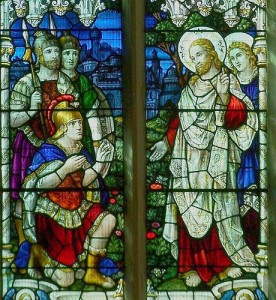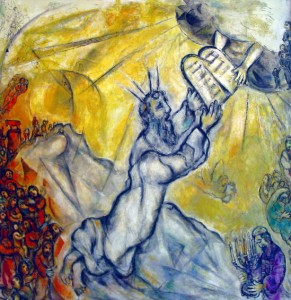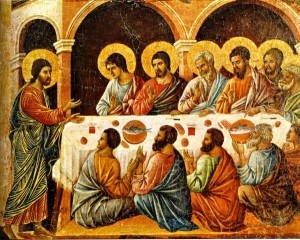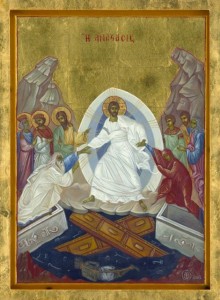Revised Common Lectionary for the 5th Sunday in Easter, Year B: Acts 8:26-40, Psalm 22:24-30, 1 John 4:7-21, and John 15:1-8
On Thursday of this past week, a client of the food pantry of St. Peter’s Episcopal Church in Ellicott City, Maryland, shot and killed the parish secretary, Brenda Brewington; shot and critically wounded one of the parish priests, the Rev. Dr. Mary-Marguerite Kohn; and then shot and killed himself. His name was Douglas Jones. The cutting short of those lives is not the sort of pruning about which Jesus speaks in today’s gospel lesson, but I could not let go of that image as I thought about and prayed about what happened in Maryland. As you all know, we here at St. Paul’s have our own regular food pantry ministry – the Free Farmers’ Market – and, on occasion, volunteers, including me although I don’t work the Market as often as I used to, have been threatened with violence by clients who have clearly had some cognitive dysfunction. The same has happened on weekdays when needy persons have come to the office seeking assistance; we have had uncomfortable and sometimes scary incidents in the office. I have never taken them very seriously. Perhaps I should. But I do not believe that the murder of church workers, lay or ordained, is the sort of “pruning” Jesus is here talking about. On the other hand, I have no doubt that from this tragedy in Maryland there will come much fruit. I have no doubt because I have heard the resolve in the voice of the bishop of Maryland, in the words of the parish and diocesan spokespeople who have interfaced with the media, in the reactions of clergy and laity throughout the church, and especially in the words of the parish’s rector, Fr. Kirk Kubicek. There will be growth from this horrible event because, while this is not the sort of pruning our Lord describes in this gospel lessons, the determination with which those most affected are facing this heartbreak, is the fruit of the Vine which is Christ, the Vine of which we are also branches. Today, in our prayers, we will pray for repose for those who died and for strength for those left behind.
Well . . . .
 I hadn’t really planned to do a sermon series about my childhood summers spent with Edgar and Edna Funston, but these “I am” statements of Jesus from the Fourth Gospel keep taking me back there, so once again . . . a story from Winfield, Kansas, fifty years ago.
I hadn’t really planned to do a sermon series about my childhood summers spent with Edgar and Edna Funston, but these “I am” statements of Jesus from the Fourth Gospel keep taking me back there, so once again . . . a story from Winfield, Kansas, fifty years ago.
It was the summer of 1961, that was the second summer my cousins were there as well. Bob – two years old then me, Randy – 20 months younger, and I decided we wanted to build a tree house. So we asked Granddad if we could do that and he said, “Yes.” He didn’t ask which tree we were thinking of using, and he didn’t give us any direction . . . he just said, “OK.” So we proceeded to build our tree house in his prize pie cherry tree.
My grandmother made wonderful cherry pies from that trees fruit. I think those cherry pies are the reason that’s my favorite kind of pie . . . and why I’m usually disappointed when I order my favorite kind of pie in a restaurant. They were my grandfather’s favorite pies, too.
That’s probably why he got so angry when he saw what we’d done. I’m sure he thought he’d never see another cherry pie from that tree again. Back in 1961 grandfathers could still spank their grandsons . . . and he did. Fifty years later and I still remember it. He also tore down the tree house we’d worked so hard to build.
Fast forward several months to June, 1962. Back in those days the Los Angeles Unified School District ended classes on the last school before Memorial Day (which wasn’t always on a Monday like it is now) and started them on the Tuesday after Labor Day (which always was the first Monday of September). My mom would always arrange to take a week of vacation the second week of June so she could drive me to Kansas, so I’d usually arrive at my grandparents sometime between the 5th and the 10th of June. That just happens to be cherry picking season in southeast Kansas. I usually looked forward to that . . . but not in 1962. Like my granddad, I was sure there would be no cherry harvest, and I was sure that he would again make his displeasure known.
Well, contrary to all expectations, not only was there a cherry harvest, it was the largest harvest from that tree in several years. My grandfather’s first words to me that summer were, “I owe you an apology. I guess that tree needed pruning.” It wasn’t the most attractive and artful job of pruning that Bob and Randy and I had done, but it was effective. We enjoyed more cherry pies that summer than you could imagine! And Grammy canned cherries for weeks.
I learned two things from that episode. One was that an honorable person apologizes when he’s proven wrong. My grandfather was nothing if not honorable. The second was the value of pruning. I’m a terrible gardener. I don’t enjoy it and I usually produce next to nothing useful when I try, but I know (because of that cherry tree) the purpose and value of pruning.
So when Jesus, in this the seventh and last of the great “I am” statements in John’s Gospel, talks about pruning, I know exactly what he is saying. I know what pruning is, I know that pruning can be painful, and I know that pruning produces results.
Last week, you’ll remember, we heard another of the “I am” statements: “I am the Good Shepherd,” Jesus said then. These metaphors that Jesus uses, these agricultural pictures that Jesus paints for us last Sunday and today are graphic reminders of our total dependence upon God, our pitiful inability to flourish with his nurturing. Sheep without a shepherd who (unlike the hired hand) remains with them in danger, even at the cost of his life, stray to solitary deaths. Vines without a a skilled vineyard keeper to prune away superfluous, misguided, and barren branches bear little or no fruit. Jesus didn’t say as much last week, but flocks like vines need to be cut back.
Where I was living in Ireland last summer was a livestock producing area. My cottage was on a cattle farm, not a ranch … they don’t have ranches in Ireland! Anyway, my landlords, John and Marion, would by a dozen or so steer calves each year, fatten them for some several months, and then sell them to be slaughtered for beef. One evening over a beer, John told me that one gets to know the cows; they each have a personality and as one moves them from field to field you get to know them. So when slaughter time comes, it is sort of sad. “But,” he said, “I don’t know how my neighbour does it.” His neighbour had a lambing operation. He was there for the birth of each lamb. His children would name them. The lambs were practically members of the family! And, yet, at various times the neighbouring shepherd would have to make a decision: which lambs to cull, to send for slaughter, which to keep for breeding stock, which to sell to someone else as breeding stock. “I don’t know how you do that,” John said.
Every day I would take a long walk down that road accompanied by the farm dog Buddy and on some days I would see the shepherd out with the sheep and the lambs. One day I could tell by his demeanor that it was that day, that he was selecting among the lambs those who would be taken away for slaughter and those that would be kept for breeding. This was not a large industrial operation; this was a small family-run farm and I am sure that, as Jesus said in last week’s gospel, he knew each of those lambs. But what had to be done had to be done, sad though it might have made that shepherd.
Culling the flock or cutting the vine in the right place are exacting, necessary tasks which the skilled shepherd or vine grower must do. Unpruned, vines grow in wild, unruly ways, exploding with new branches and great leafy cascades, but few grapes. Unwatched, sheep scatter and lose their way, wandering heedlessly into danger; unculled, a flock weakens and all of the sheep suffer.
Flocks of sheep are disorderly and topsy-turvy crowds. Vines and their branches are similarly tangled and messy. With either, it’s just too hard to know what is what. Not only are we dependent on Jesus the Shepherd, on God the Vinedresser, but our lives are uncomfortably tangled up together. The Christian life is a flock-y, vine-y, branch-y, mixed-up mess of us and Jesus and others.
I think only one or two of us may have culled a flock, but I know that all of us have, at one time or another, pruned our suburban hedges or shrubs. You may have experienced, as I have, a feeling of hesitation, that unwillingness to strip away what have been thriving branches for a greater and unseen future good. But what, with all that tangle of branches, are the alternatives?
Over the past several years there has been much hand wringing over the state of the church, its decline in membership, its loss of congregations, the shrinking of parish budgets, and so forth. We’ve looked at statistical graphs, at flow charts, at columns upon columns of figures, and we’ve pointed fingers at one another, at those who left, at the secular world around us, and at all sorts of other things seeking someone or something to blame for it all. In the Episcopal Church, we’ve blamed our loss of membership on new prayer books or on old prayer books, on women in Holy Orders or on failure to receive women in the clergy, on the acceptance (or the lack of acceptance) of gays and lesbians, on old style music or on new kinds of music, never noticing that the same statistical declines were happening in all the mainline denominations where none of those things were issues. We have wrung our hands and cried out to one another, “We’re dying on the vine here!”
I believe that today’s gospel lesson gives us a different way to look at things. We on the Vine, that’s for sure! But we ain’t dying on it. I believe these past several years have been a time of cutting back, that we are the branches that remain after the Vinedresser has done his pruning, the flock that is now smaller after the Shepherd has done his culling. And I believe that means we are on the verge of a time of new and exciting growth, a productive time of bearing fruit, a time of expanding the flock. We have all that we need to do that because we have the promise of the gospel: “Those who abide in me and I in them bear much fruit. . . . If you abide in me, and my words abide in you, ask for whatever you wish, and it will be done for you. My Father is glorified by this, that you bear much fruit and become my disciples.”
We know this! These are the most important words in epistle lesson from First John today: “We know that we abide in him.” Right there in your lesson insert; find those words and read them with me . . . “We know that we abide in him.” Again – “We know that we abide in him.” One more time – “We know that we abide in him.” With feeling! “We KNOW that we abide in him.”
We know that we abide in him. We know that we are loved by God, and so we also must love.
The most important words in the reading from the Book of Acts today are right at the beginning lesson: “An angel of the Lord said to Philip, ‘Get up and go’.” All the rest there, that story about the Ethiopian Eunuch, that’s just an example; it’s window dressing. The important words are “Get up and go!” Can you say those words with me? “Get up and go!” I want you to turn to the person next to you; I want you to be an angel to that person; I want you to say to that person, “Get up and go!” Go on, now! Say to that person next to you, “Get up and go!”
Get up and go! God’s love, our love must send us out, out of the church, out of our comfort zone, into the uncomfortable and unlovable circumstances around us. We must get up and go into places where love is absent; we must get up and go to people to whom love is simply unknown. To abide in Jesus, to be loved by God is to be given a mission, a mission to get up and go with what we know to those who cannot accept it, to the destitute, the broken, the lost, the hopeless; a mission to get up and go, not to tell them what we know, but to show them what we know, through our lives and by our actions. That is how and when we will bear fruit; that is how and when we will grow. Not merely to know that we abide in him, but to show that we abide in him!
We know … so get up and go … and show. Know, go, show! That is how we shall bear fruit and grow.
Let us pray:
Heavenly Father, you know our world is broken, sinful, and shameful, filled with hate and with pain. Because of that brokenness and pain Brenda, and Mary-Marguerite, and Douglas died. Because of that brokenness and pain your Son our Savior Jesus Christ died. But in him you showed us that your love and your life know no bounds, are held back by no obstacles, not even death. Give us the faith to know that we abide in him, the faith to get up and go, the faith to show love even to the least lovable of people, in the least lovable of places, at the least lovable of times; Lord, give us the faith to know, to go, and to show, that we may bear fruit and grow, through Jesus Christ our Lord. Amen.
 I love this Psalm – it’s about liturgy and worship, something dear to my heart!
I love this Psalm – it’s about liturgy and worship, something dear to my heart!  In our lessons today, we have two stories about silencing the prophetic voice. First, a snippet of the not-very-familiar story of the Prophet Amos which is, frankly, cut from its context so badly that some explanation really is necessary. Second, the almost-too-familiar story of the beheading of John the Baptizer.
In our lessons today, we have two stories about silencing the prophetic voice. First, a snippet of the not-very-familiar story of the Prophet Amos which is, frankly, cut from its context so badly that some explanation really is necessary. Second, the almost-too-familiar story of the beheading of John the Baptizer.  Did you listen carefully or perhaps even follow along in the Prayer Book when I offered our opening prayer today, the Collect for Trinity Sunday? Listen to it again:
Did you listen carefully or perhaps even follow along in the Prayer Book when I offered our opening prayer today, the Collect for Trinity Sunday? Listen to it again: The words of the centurion are the root of a prayer spoken by many before receiving Holy Communion: “Lord, I am not worthy to receive you, but only say the word and I shall be healed.” As an Anglo-Catholic Episcopalian, recitation of this prayer used to be a part of my personal practice. But I have ceased to say it because I became uncomfortable about the change in emphasis from the biblical text to the liturgical text. A statement of faith in Christ’s power to heal another has been turned into a purely personal (and one is tempted to say “selfish”) prayer. ~ Paragraph 1386 of the catechism of the Roman Catholic Church explains the rational of the prayer: “Before so great a sacrament, the faithful can only echo humbly and with ardent faith the words of the Centurion: ‘Domine, non sum dignus ut intres sub tectum meum, sed tantum dic verbo, et sanabitur anima mea’ (‘Lord, I am not worthy that you should enter under my roof, but only say the word and my soul will be healed.’)” That’s great, except the quotation from the Centurion is inaccurate! In the Vulgate, the verse reads, “Tantum dic verbo et sanabitur puer meus.” (“Only say the word and my servant [or ‘child’] shall be healed.”) I am troubled reciting a prayer based on a misquotation of scripture. ~ The centurion in the story is about as far from self-centered as one can be. He seeks Jesus’ help not for himself but for his servant. He is unwilling for Jesus to be inconvenienced. It is in that spirit that he speaks these words, explaining that as a military officer he simply gives orders and things are done, so he has faith that One with the power of healing can simply do the same. It is for his selflessness that Jesus’ praises him and his faith. It seems somehow wrong to recite a prayer which turns that on its head! ~ I recall reading a few years ago about a medical brain-function study which demonstrated that selflessness is psychologically healthy and is the neuropsychological foundation of spiritual experience. Selfishness, on the other hand, is unhealthy: other scientific studies have demonstrated that it is impossible for a completely selfish individual to either survive or have a biological future. So I am unwilling to utter a prayer which turns a selfless intercession on behalf of another into a self-centered (one is tempted to say “selfish”) petition. “Lord, I am unworthy to receive you” … let’s just leave it at that.
The words of the centurion are the root of a prayer spoken by many before receiving Holy Communion: “Lord, I am not worthy to receive you, but only say the word and I shall be healed.” As an Anglo-Catholic Episcopalian, recitation of this prayer used to be a part of my personal practice. But I have ceased to say it because I became uncomfortable about the change in emphasis from the biblical text to the liturgical text. A statement of faith in Christ’s power to heal another has been turned into a purely personal (and one is tempted to say “selfish”) prayer. ~ Paragraph 1386 of the catechism of the Roman Catholic Church explains the rational of the prayer: “Before so great a sacrament, the faithful can only echo humbly and with ardent faith the words of the Centurion: ‘Domine, non sum dignus ut intres sub tectum meum, sed tantum dic verbo, et sanabitur anima mea’ (‘Lord, I am not worthy that you should enter under my roof, but only say the word and my soul will be healed.’)” That’s great, except the quotation from the Centurion is inaccurate! In the Vulgate, the verse reads, “Tantum dic verbo et sanabitur puer meus.” (“Only say the word and my servant [or ‘child’] shall be healed.”) I am troubled reciting a prayer based on a misquotation of scripture. ~ The centurion in the story is about as far from self-centered as one can be. He seeks Jesus’ help not for himself but for his servant. He is unwilling for Jesus to be inconvenienced. It is in that spirit that he speaks these words, explaining that as a military officer he simply gives orders and things are done, so he has faith that One with the power of healing can simply do the same. It is for his selflessness that Jesus’ praises him and his faith. It seems somehow wrong to recite a prayer which turns that on its head! ~ I recall reading a few years ago about a medical brain-function study which demonstrated that selflessness is psychologically healthy and is the neuropsychological foundation of spiritual experience. Selfishness, on the other hand, is unhealthy: other scientific studies have demonstrated that it is impossible for a completely selfish individual to either survive or have a biological future. So I am unwilling to utter a prayer which turns a selfless intercession on behalf of another into a self-centered (one is tempted to say “selfish”) petition. “Lord, I am unworthy to receive you” … let’s just leave it at that.
 I hadn’t really planned to do a sermon series about my childhood summers spent with Edgar and Edna Funston, but these “I am” statements of Jesus from the Fourth Gospel keep taking me back there, so once again . . . a story from Winfield, Kansas, fifty years ago.
I hadn’t really planned to do a sermon series about my childhood summers spent with Edgar and Edna Funston, but these “I am” statements of Jesus from the Fourth Gospel keep taking me back there, so once again . . . a story from Winfield, Kansas, fifty years ago. When I joined the Episcopal Church in high school, the last verse of this quotation was the favorite offertory sentence of the parish priest – in the King James Version, of course: “Let your light so shine before men, that they may see your good works, and glorify your Father which is in heaven.” If he didn’t say that one, he said, “Not every one that saith unto me, Lord, Lord, shall enter into the kingdom of heaven; but he that doeth the will of my Father which is in heaven.” (Matt. 7:21 KJV) I memorized those verses not by reading them, but by hearing one or the other at every service as the invitation to make a gift to God. I learned the lesson of an active faith, of being public and “out there” with my beliefs, of doing the will of the Father, from hearing those simple but profound verses at every service. ~ I love the 1979 Book of Common Prayer and its many options for worship, but I wonder whether in our quest for variety in worship we have left behind the wisdom of simple, repetitive teaching. In our current worship practice we are directed by a rubric to offer prayers for the Universal Church, its members, and its mission; for the Nation and all in authority; for the welfare of the world; for the concerns of the local community; for those who suffer and those in any trouble; and for the departed . That’s well and good, but the way in which these prayers are offered is left up to the designers of each service or to the presiding ministers and, in fact, variety seems to be encouraged. On the other hand, in our previous prayer book (and all those that preceded it) there was one prayer “for the whole state of Christ’s church.” Every Sunday, the same prayer was offered; the same lesson of the need for prayer was taught. ~ That standard prayer included the every Sunday petition that God “inspire continually the Universal Church with the spirit of truth, unity, and concord: And grant that all those who do confess thy holy Name may agree in the truth of thy holy Word, and live in unity and godly love.” Is it possible, just the least bit possible, that some of our current discord in the church is because we’ve stopped hearing these words, stopped teaching and learning the lesson of “truth, unity, and concord”, stopped trusting God to support us in agreement, unity, and “godly love”? Have we extinguished our light, have we stopped shining that light before others because we’ve stopped offering and hearing these simple, repetitive lessons? ~ I don’t know. And I love variety in worship. But remembering those every Sunday offertory sentences, those every Sunday petitions for unity, I’m beginning to wonder.
When I joined the Episcopal Church in high school, the last verse of this quotation was the favorite offertory sentence of the parish priest – in the King James Version, of course: “Let your light so shine before men, that they may see your good works, and glorify your Father which is in heaven.” If he didn’t say that one, he said, “Not every one that saith unto me, Lord, Lord, shall enter into the kingdom of heaven; but he that doeth the will of my Father which is in heaven.” (Matt. 7:21 KJV) I memorized those verses not by reading them, but by hearing one or the other at every service as the invitation to make a gift to God. I learned the lesson of an active faith, of being public and “out there” with my beliefs, of doing the will of the Father, from hearing those simple but profound verses at every service. ~ I love the 1979 Book of Common Prayer and its many options for worship, but I wonder whether in our quest for variety in worship we have left behind the wisdom of simple, repetitive teaching. In our current worship practice we are directed by a rubric to offer prayers for the Universal Church, its members, and its mission; for the Nation and all in authority; for the welfare of the world; for the concerns of the local community; for those who suffer and those in any trouble; and for the departed . That’s well and good, but the way in which these prayers are offered is left up to the designers of each service or to the presiding ministers and, in fact, variety seems to be encouraged. On the other hand, in our previous prayer book (and all those that preceded it) there was one prayer “for the whole state of Christ’s church.” Every Sunday, the same prayer was offered; the same lesson of the need for prayer was taught. ~ That standard prayer included the every Sunday petition that God “inspire continually the Universal Church with the spirit of truth, unity, and concord: And grant that all those who do confess thy holy Name may agree in the truth of thy holy Word, and live in unity and godly love.” Is it possible, just the least bit possible, that some of our current discord in the church is because we’ve stopped hearing these words, stopped teaching and learning the lesson of “truth, unity, and concord”, stopped trusting God to support us in agreement, unity, and “godly love”? Have we extinguished our light, have we stopped shining that light before others because we’ve stopped offering and hearing these simple, repetitive lessons? ~ I don’t know. And I love variety in worship. But remembering those every Sunday offertory sentences, those every Sunday petitions for unity, I’m beginning to wonder. The rest of today’s Daily Office reading from the Hebrew Scriptures sets out the Ten Commandments. My first thoughts were of those and wondering whether the course of world history might have been different if the Lord had laid out those laws in an affirmative rather than a negative style. You know – said something like “You shall hold all life in reverence” rather than “You shall not murder” (Exod. 20:13) or “You will respect your neighbor’s right of possession” rather than “You shall not steal” (Exod. 20:15). But then the ending verses caught my eye and I immediately thought, “Incense!” ~ OK, not immediately … but I did think of incense and liturgy. Smoke and lightning and loud noises and a leader separated from the people to do special things vis-à-vis God (so the people don’t have to do them for themselves, because – God knows! – those things are downright dangerous!). Skip forward several generations and you have the liturgy of the Temple . . . skip forward several more generations and you have the liturgy of the Church. As I thought about today’s Exodus reading, I realized that the liturgy of temple and church is about recreating Sinai; liturgy is an attempt to experience in the here-and-now what the Hebrews experienced in this encounter with God. And I began to ask, “Is this what has put us on the trajectory of irrelevance and disbelief?” ~ The stagecraft of temple and church became the stagecraft of the theatre, of vaudeville, of burlesque, of the stage magician. There is very little difference between staging a good worship service and staging a good theatrical or musical production. Use of “props”, use of lighting, use of stage technique . . . it all started in the temple and the church, and was borrowed by the entertainment stage (in fact, one might argue that the Western European way of staging dramas and other forms of entertainment in some sense originated in the church with medieval “passion plays” and whatnot). And now, today, the flow is in the opposite direction: the staging techniques of the rock concert have replaced the formal liturgy in many independent congregations and so-called megachurches. This is so well-known that there’s even a very funny parody of the situation on
The rest of today’s Daily Office reading from the Hebrew Scriptures sets out the Ten Commandments. My first thoughts were of those and wondering whether the course of world history might have been different if the Lord had laid out those laws in an affirmative rather than a negative style. You know – said something like “You shall hold all life in reverence” rather than “You shall not murder” (Exod. 20:13) or “You will respect your neighbor’s right of possession” rather than “You shall not steal” (Exod. 20:15). But then the ending verses caught my eye and I immediately thought, “Incense!” ~ OK, not immediately … but I did think of incense and liturgy. Smoke and lightning and loud noises and a leader separated from the people to do special things vis-à-vis God (so the people don’t have to do them for themselves, because – God knows! – those things are downright dangerous!). Skip forward several generations and you have the liturgy of the Temple . . . skip forward several more generations and you have the liturgy of the Church. As I thought about today’s Exodus reading, I realized that the liturgy of temple and church is about recreating Sinai; liturgy is an attempt to experience in the here-and-now what the Hebrews experienced in this encounter with God. And I began to ask, “Is this what has put us on the trajectory of irrelevance and disbelief?” ~ The stagecraft of temple and church became the stagecraft of the theatre, of vaudeville, of burlesque, of the stage magician. There is very little difference between staging a good worship service and staging a good theatrical or musical production. Use of “props”, use of lighting, use of stage technique . . . it all started in the temple and the church, and was borrowed by the entertainment stage (in fact, one might argue that the Western European way of staging dramas and other forms of entertainment in some sense originated in the church with medieval “passion plays” and whatnot). And now, today, the flow is in the opposite direction: the staging techniques of the rock concert have replaced the formal liturgy in many independent congregations and so-called megachurches. This is so well-known that there’s even a very funny parody of the situation on  I have to admit that I would be hard-pressed to choose one of the many post-resurrection appearances of Christ as my favorite. Each one recorded in Scripture is so full of vivid imagery and meaning that it would be nearly impossible to put one above another … having said that, however, I also have to admit an especial fondness for the one described here by Luke.
I have to admit that I would be hard-pressed to choose one of the many post-resurrection appearances of Christ as my favorite. Each one recorded in Scripture is so full of vivid imagery and meaning that it would be nearly impossible to put one above another … having said that, however, I also have to admit an especial fondness for the one described here by Luke.  If you’ve been with us here for the services of Maundy Thursday, Good Friday, and Holy Saturday, or have been following the sermons on line, you know that we have come to Act Three of the three-act drama of redemption. In the first act, we saw the protagonist, Jesus of Nazureth, trying one last time make his disciples understand his mission and his message. Through the metaphor of bread and wine, through the enacted parable of foot-washing, through an agonized night of prayer in a garden, he tried to teach them that his was a mission of love and life, but they just didn’t seem to get it. As the curtain fell on Act One, he was being taken away to be questioned by Jewish and Roman authorities and the disciples, frightened and confused, were scattering, unsure of what was going to happen next.
If you’ve been with us here for the services of Maundy Thursday, Good Friday, and Holy Saturday, or have been following the sermons on line, you know that we have come to Act Three of the three-act drama of redemption. In the first act, we saw the protagonist, Jesus of Nazureth, trying one last time make his disciples understand his mission and his message. Through the metaphor of bread and wine, through the enacted parable of foot-washing, through an agonized night of prayer in a garden, he tried to teach them that his was a mission of love and life, but they just didn’t seem to get it. As the curtain fell on Act One, he was being taken away to be questioned by Jewish and Roman authorities and the disciples, frightened and confused, were scattering, unsure of what was going to happen next.

